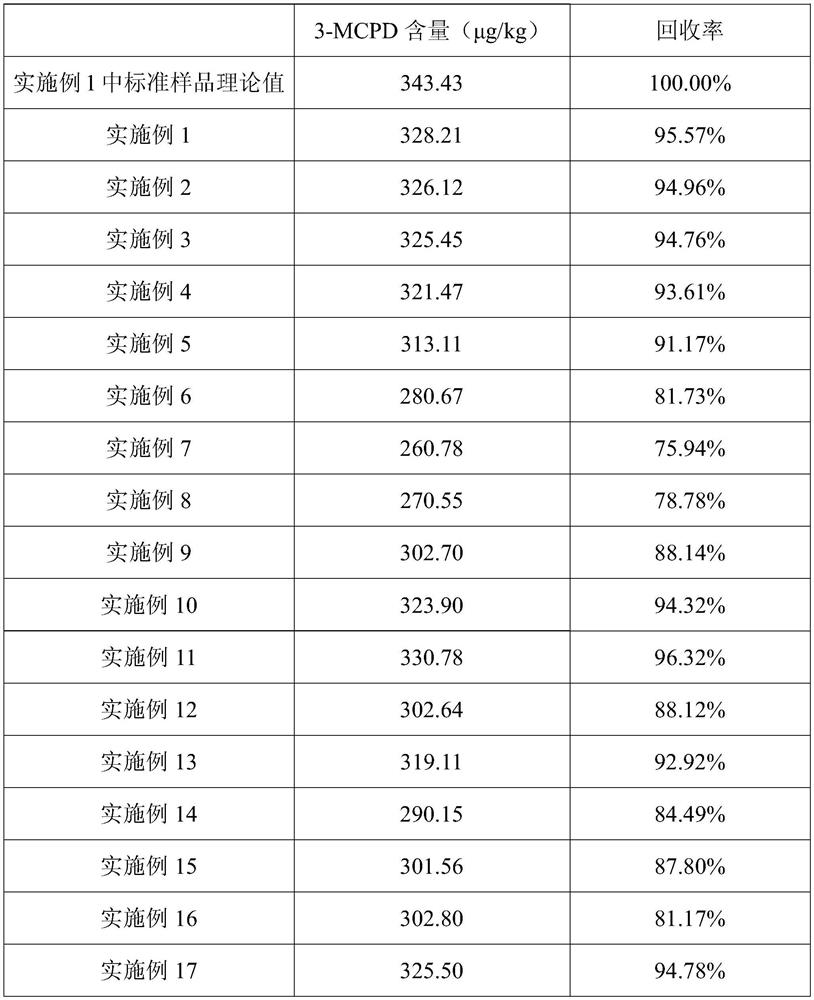A kind of quantitative method of chloropropanol fatty acid ester
A technology of fatty acid ester and chloropropanol, which is applied in measurement devices, instruments, scientific instruments, etc., can solve the problems of large difference in reaction rate, long time consumption, low detection efficiency, etc., to improve quantitative analysis efficiency and improve quantitative analysis. Efficiency, high sample recovery effect
- Summary
- Abstract
- Description
- Claims
- Application Information
AI Technical Summary
Problems solved by technology
Method used
Image
Examples
Embodiment 1
[0078] Standard solution preparation: Take 10.00 mg of 3-chloro-1,2-propane dipalmitate and dilute to volume in a 10 mL volumetric flask to obtain a mother solution with a concentration of 1.000 mg / mL. Dilute the mother liquor sequentially into standard solutions with concentrations of 0.50mg / L, 1.000mg / L, 2.000mg / L, 5.000mg / L, and 10.000mg / L, and then add glycidol and sodium chloride solution to it to make glycidol The concentration of ions was 100 μg / L and the concentration of chloride ions was 21.0 μg / L.
[0079] Dilute 10.00mg of d5-3-chloro-1,2-propanedipalmitate to a 10mL volumetric flask to obtain a mother solution with a concentration of 1.0000mg / mL, and dilute the mother solution gradually to a concentration of 2.000mg / L.
[0080] Experimental steps:
[0081] (1) Sample extraction and water washing: Take 0.5mL standard sample (2.00mg / L) in a centrifuge tube, add 45μL of d5-pp-3-MCPD (the concentration is equivalent to 2.000mg / L of d5-3- MCPD standard solution), 7.0m...
Embodiment 2
[0086] The difference from Example 1 is that the ultrasonic power in the acid-catalyzed transesterification step is 240W, the microwave power is 960W, and the rest of the steps are the same. The specific quantitative analysis results are shown in Table 1.
Embodiment 3
[0088] The difference from Example 1 is that the ultrasonic power in the acid-catalyzed transesterification step is 240W, the microwave power is 1440W, and the rest of the steps are the same. The specific quantitative analysis results are shown in Table 1.
PUM
 Login to View More
Login to View More Abstract
Description
Claims
Application Information
 Login to View More
Login to View More - R&D Engineer
- R&D Manager
- IP Professional
- Industry Leading Data Capabilities
- Powerful AI technology
- Patent DNA Extraction
Browse by: Latest US Patents, China's latest patents, Technical Efficacy Thesaurus, Application Domain, Technology Topic, Popular Technical Reports.
© 2024 PatSnap. All rights reserved.Legal|Privacy policy|Modern Slavery Act Transparency Statement|Sitemap|About US| Contact US: help@patsnap.com









